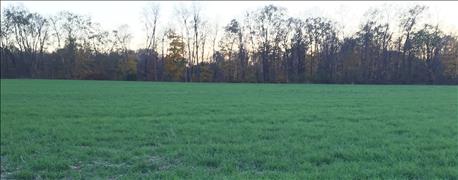
While the winter winds are howling and the snow is piling up, now is the time to finalize your termination plan for your cover crops that don’t winter-kill. Don Donovan works with farmers who have a termination plan that begins at planting and continues until termination. Donovan is a district conservationist with the Natural Resources Conservation Service.
Donovan, other NRCS personnel, and other members of the Indiana Conservation Partnership prepare information to help those who raise cover crops manage them properly.

UP AND GROWING: As long as cereal rye emerged in the fall, there’s a good chance it will be successful this spring. Make termination plans now. (Photo courtesy of Chris Vance, NRCS)
Farmers who plan ahead scout their cover crop fields, and they're flexible and ready to make changes as needed, Donovan begins. Each cover crop species that overwinters has concerns that need to be a part of the cover crop termination plan.
Cereal rye before corn
Cereal rye is a spring-growing cover crop. Donovan says no matter how much growth you had in the fall, when it warms up this spring, cereal rye will take off and grow. Therefore, you need to scout it frequently.
If you’re planting corn after cereal rye, adapt to the potential for nitrogen tie-up if the rye gets very tall and mature. Successful cover crop farmers throughout Indiana find that if they terminate their cereal rye while it’s still in the vegetative stage, less than 12 inches tall, they don’t see a lack of available nitrogen for their young corn crop, Donovan notes.
To be on the safe side, these farmers put on some nitrogen in their starter fertilizer to ensure that the young crop has sufficient nitrogen in the early growth stages.
Cereal rye before soybeans
Farmers who plant soybeans into a cereal rye cover crop have other concerns, Donovan says. Soybeans can do well in a nitrogen-starved environment. But if the rye gets too large, you may have soil moisture issues. When rye is in its rapid growth stage, it can remove large amounts of water from the soil. This can be good if it’s a wet spring, but not so good if it’s a dry spring. Keep an eye on your cover crop and the soil moisture, Donovan advises.
Be cautious about terminating rye too far in advance of planting soybeans, especially in mature rye stands. Once terminated, dead rye can become matted on the soil surface and keep it from drying out. To overcome this, many farmers have success terminating immediately prior to or after planting soybeans into "green" standing rye.
If weed control from your cover crop is one of your goals, you will need as much growth of the rye as possible, Donovan says. So be prepared to deal with potential issues, and scout for pests frequently.
Cereal rye is a great cover crop with a multitude of benefits to your system, Donovan observes. Making it work for you means management and scouting. Finalize your termination plan today, he advises.
About the Author(s)
You May Also Like




